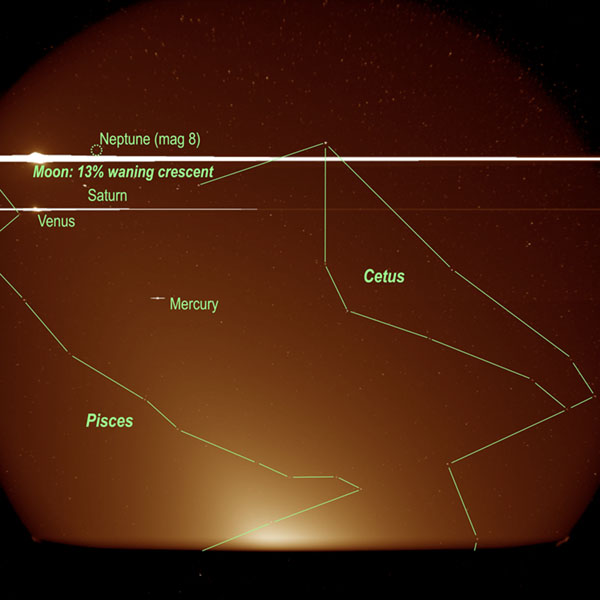WFI-1 sees four planets and a crescent moon
This is a PUNCH Science Nugget

During commissioning, the PUNCH WFI-1 spacecraft captured this image on 4/24/2025: the quadruple conjunction of Moon, Venus, Saturn, and Neptune, with Mercury nearby.
There've been lots of stories about this week’s triple-conjunction smiley moon in the media. We happened to catch the conjunction during PUNCH commissioning, along with two other planets besides!
We've been pushing our exposure sequences a little farther, shaking out each instrument. WFI-1 caught this single exposure of four planets on 24-April-2025 at 19:42 UT. The Moon, Venus, Saturn, and Neptune are all crowded together near the head of Pisces, at upper left. Mercury is also visible nearby. In the image, “up” is approximately south – so the constellations may seem inverted.
We knew from the get-go that some objects would just be too bright for us to image directly. The Moon is so bright that, when it is in the field of view, it may "wash out" part of our images and prevent us from seeing the solar wind in a portion of the sky. So an important part of commissioning is photographing the Moon to see just how badly the glare affects the rest of each image. The fact that we can see 8th magnitude Neptune (which is invisible to the naked eye), right next to the Moon’s glare, is a nice indicator of how well the WFI optics (which were made by Tele Vue) are working.
Appendix: What’s up with those weird-looking planets?
Mercury, Venus, and the Moon look more than a little weird in this image. To know why, you have to understand how PUNCH makes images. Our detector is a CCD: it is a silicon chip with an array of 2048 x 2048 light-sensitive pixels. Each pixel is a little "charge bucket" of silicon, that can hold a small amount of electrical charge. Electrically, it is a small capacitor, insulated from its surroundings. Light landing on the pixel knocks electrons loose from the silicon itself, and they get caught in the capacitor. There is microcircuitry between pixels, to allow us to transfer the charge *horizontally* across the detector for readout, like a bucket brigade of people putting out a fire. The final column of the detector has transfer electronics to transfer each bucket of charge *vertically*, one pixel at a time, into a digitizer that counts up how many electrons were recorded by each pixel. The values that come out of the digitizer are the image we use.
Really bright objects like Mercury, and the dozen brightest stars, fill up their charge buckets completely. The electrons literally overflow into adjacent buckets, along the pathway we normally use for readout. That is harmless but makes little horizontal "wings" on the image. Extremely bright objects like, say, Venus can spill outward across half the visible image or more. The Moon is so bright that electrons from its image splash all the way across the detector, and secondary effects (like the small amount of scattering inside our lenses) create a small halo of glare around the Moon itself in the picture. The brightness of that halo is what we were checking with this image – but the bright "saturation spikes" are far more dramatic looking. Other missions see those effects also. Famously, SOHO/LASCO has spikes from Mercury and Venus when they pass through its field – and every once in a while someone decides that they must actually be alien spacecraft or something, which they aren't.
PUNCH science nuggets are archived on our News Page.



